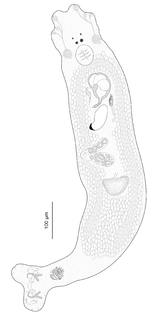
The mottled grouper is a species of marine ray-finned fish, a grouper from the subfamily Epinephelinae which is part of the family Serranidae, which also includes the anthias and sea basses. It is found in the eastern Atlantic Ocean and the Mediterranean Sea.

Pseudorhabdosynochus is a genus of monopisthocotylean monogeneans, included in the family Diplectanidae. The type-species of the genus is Pseudorhabdosynochus epinepheli .

Pseudorhabdosynochus regius is a diplectanid monogenean parasitic on the gills of the mottled grouper .

Pseudorhabdosynochus sulamericanus is a diplectanid monogenean parasitic on the gills of the snowy grouper, Epinephelus niveatus, the Warsaw grouper, Epinephelus nigritus and the Haifa grouper, Epinephelus haifensis. It has been described by Santos, Buchmann & Gibson in 2000 , redescribed by Kritsky, Bakenhaster and Adams in 2015. and again redescribed by Chaabane, Justine, Gey, Bakenhaster & Neifar in 2016.

Pseudorhabdosynochus beverleyburtonae is a diplectanid monogenean parasitic on the gills of the dusky grouper, Epinephelus marginatus. It has been described by Guy Oliver in 1984 as Cycloplectanum beverleyburtonae, redescribed by Oliver in 1987, transferred to the genus Pseudorhabdosynochus by Kritsky & Beverley-Burton in 1986 as Pseudorhabdosynochus beverleyburtonae, redescribed by Kritsky, Bakenhaster and Adams in 2015, and redescribed in 2016 by Chaabane, Neifar, Gey & Justine.
Pseudorhabdosynochus buitoe is a diplectanid monogenean parasitic on the gills of the Highfin grouper, Epinephelus maculatus. It has been described in 2007.
Pseudorhabdosynochus bacchus is a diplectanid monogenean parasitic on the gills of groupers. It was described in 2007.
Pseudorhabdosynochus variabilis is a diplectanid monogenean parasitic on the gills of the grouper Epinephelus morrhua. It has been described in 2008.

Pseudorhabdosynochus hayet is a diplectanid monogenean parasitic on the gills of the mottled grouper .

Pseudorhabdosynochus oliveri is a diplectanid monogenean parasitic on the gills of the dusky grouper.

Pseudorhabdosynochus bouaini is a diplectanid monogenean parasitic on the gills of groupers. It has been described in 2007 by Lassad Neifar & Louis Euzet. The species has been redescribed by Amira Chaabane, Lassad Neifar, and Jean-Lou Justine in 2017.

Pseudorhabdosynochus dolicocolpos is a diplectanid monogenean parasitic on the gills of groupers. It has been described in 2007 by Lassad Neifar & Louis Euzet. The species name refers to the size of the vagina and is derived from the Greek words “dolicos” meaning long and “colpos” vagina. The species has been redescribed by Amira Chaabane, Lassad Neifar, and Jean-Lou Justine in 2017.

Pseudorhabdosynochus sinediscus is a diplectanid monogenean parasitic on the gills of groupers. It has been described in 2007 by Lassad Neifar & Louis Euzet. The name refers to the absence of squamodiscs and is derived from the Latin “sine”, indicating absence, and “discus”, contraction of “squamodiscus”.

Pseudorhabdosynochus sosia is a diplectanid monogenean parasitic on the gills of groupers. It has been described in 2007 by Lassad Neifar & Louis Euzet. According to Neifar & Euzet, the name of the species refers to Sosia, who in Plautus’ comedy Amphitryon confronts his double, and to the resemblance of the vagina of P. sosia to that of P. beverleyburtonae.
Pseudorhabdosynochus satyui is a species of diplectanid monogenean that is parasitic on the gills of the Hong Kong grouper. It was described in 2009.

Pseudorhabdosynochus jeanloui is a diplectanid monogenean parasitic on the gills of the Pacific creolefish, Paranthias colonus. It has been described in 2015 by Knoff, Cohen, Cárdenas, Cárdenas-Callirgos & Gomes.
Pseudorhabdosynochus crassus is a species of diplectanid monogenean that is parasitic on the gills of the camouflage grouper Epinephelus polyphekadion. It was described in 2011.
Pseudorhabdosynochus stigmosus is a species of diplectanid monogenean that is parasitic on the gills of the brownspotted grouper Epinephelus chlorostigma. It was described in 2010.
Pseudorhabdosynochus exoticus is a species of diplectanid monogenean that is parasitic on the gills of the blue grouper Epinephelus cyanopodus. It was described in 2008.

Pseudorhabdosynochus riouxi is a species of diplectanid monogenean parasitic on the gills of dusky grouper Mycteroperca marginata. It was described by Guy Oliver in 1986 as Cycloplectanum riouxi, then transferred to the genus Pseudorhabdosynochus by Santos, Buchmann & Gibson in 2000. The species has been redescribed by Chaabane et al. in 2017.















